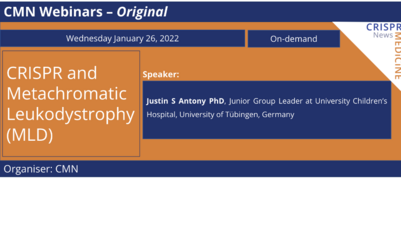Disease name: Metachromatic Leukodystrophy (MLD)
ICD-10 Disease Code: E75.25 Metachromatic leukodystrophy
ICD-10 Disease Group: E75- Disorders of sphingolipid metabolism and other lipid storage disorders
General description:Metachromatic leukodystrophy (MLD) is a rare autosomal recessive disease that arises from mutations in the ARSA gene, which encodes the Arylsulfatase A enzyme.
The Arylsulfatase-A enzyme (ARSA) plays a key role in sulfatide (a type of fat) metabolism in distinct cell types, including kidney and brain cells.
ARSA deficiency leads to perturbed sulfatide metabolism, causing increased sulfatide excretion in kidney cells without any associated pathology, a feature that is used in diagnostic testing for MLD.
However, sulfatide accumulation in the lysosomes of cells from the peripheral and central nervous system results in progressive demyelination and neurodegeneration, with loss of motor function, language, and cognitive decline.
The disease may occur in different forms in infants, young persons and adults. All forms are progressive and result in premature death.
Mutations:
MLD arises through any of approximately 300 mutations in the ARSA gene, which encodes for the Arylsulfatase A enzyme.
In rare cases, MLD may arise through mutations in the PSAP gene. These mutations result in a deficiency of the saposin B protein, which in turn interferes with the breakdown of sulfatides. This leads to sulfatide accumulation to toxic levels in the nervous system.
Disease frequency:MLD (all subtypes combined) is estimated to occur in between 1 in 40,000 and 1 in 160,000 people, however the true prevalence is unknown. The Navajo (a Native American people of the Southwestern United States), also have a higher prevalence rate of 1 in every 2,500 people. In certain populations in the Middle East, these numbers may be even higher (source: www.rarediseases.org).
Symptoms:MLD manifests as one of three subtypes that differ in their spectrum of symptoms, rate of progression and age of onset.
Over half of the children affected by MLD have late-infantile MLD. Here, symptoms typically appear within the first 3 years of life, with earliest signs difficulty in walking.
Juvenile MLD is less common and occurs in 20-30% of people with MLD. Onset is between 4 years old and sexual maturity, usually between 12 and 14 years of age. The first signs usually include behavioural problems or new difficulties in school.
In late-infantile MLD, within months of the first symptoms, most children lose the ability to talk and walk. The progression in the juvenile and adult forms can occur over years to decades.
All MLD subtypes are progressive, and regardless of the subtype, late-stage disease is often characterised by blindness, inability to move, unresponsiveness, and an inability to speak.
Treatment:Treatment regimens for MLD include haematopoietic stem cell transplantation from healthy donors or enzyme replacement. However both of these approaches have low success rates owing to risks of graft-vs-host disease, the need for immunosuppression, difficulties in finding a suitable donor, and in the case of enzyme replacement, the need to adminster treatment via the spinal cord in order to reach the brain.
So far, one specific treatment (Libmeldy, Orchard Therapeutics) based on lentiviral-modified stem cells which over-express ARSA has been approved for early-onset MLD by the European Medical Agency in late 2020. In reality for most patients, current treatment options are by and large limited to symptom management and supportive care.
Sources:- https://www.icd10data.com/
- https://www.orpha.net/consor/cgi-bin/index.php
- https://rarediseases.org/
- https://medlineplus.gov/genetics/


